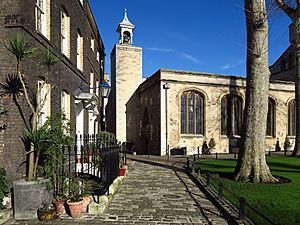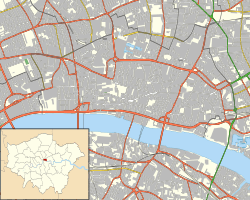Church of St Peter ad Vincula facts for kids
Quick facts for kids Church of St Peter ad Vincula |
|
|---|---|

Side of St Peter chapel that faces
the place of execution on Tower Green |
|
| 51°30′31″N 0°4′37″W / 51.50861°N 0.07694°W | |
| Location | Tower Hamlets, London |
| Country | England |
| Denomination | Church of England |
| Previous denomination | Roman Catholic |
| History | |
| Status | Active |
| Architecture | |
| Years built | 1519–20 |
| Administration | |
| Diocese | Royal Peculiar |
The Chapel Royal of St Peter ad Vincula is a special church located inside the famous Tower of London. Its name, "St Peter ad Vincula," means "St Peter in chains." This name reminds us of the story of Saint Peter being held prisoner. The church you see today was built in 1520. However, there has likely been a church here since the 1100s.
This chapel was originally for the people who lived and worked at the Tower. It was the second church built there. The first was St John's, a smaller royal chapel inside the White Tower. St Peter's is a royal peculiar, which means it is directly under the authority of the monarch, not a bishop. The priest in charge is called the chaplain of the Tower.
Inside the church, you'll find a main area called the nave and a smaller side area called the north aisle. The windows have a special design typical of the Tudor period. The chapel is most famous as the burial place for many important prisoners who were executed at the Tower. These include Queen Anne Boleyn and Queen Catherine Howard. Also buried here are Lady Jane Grey, who was queen for only nine days, and Sir Thomas More.
Contents
History of the Tower Chapel
The exact date and first location of this chapel are not fully known. The church has been destroyed, rebuilt, and moved several times over the centuries. Some historians think it might have been a local church even before the Tower was a fortress. Others believe it was started by King Henry I around 1110.
At first, the chapel might have been outside the Tower's walls. This would have allowed the king to worship in public. It was different from the more private St John's Chapel, which William I built inside the White Tower around 1080.
By the mid-1200s, during the reign of King Henry III, St Peter ad Vincula became the main chapel for everyone living in the Tower. Around this time, a crypt was built under the church. By 1241, the chapel was definitely inside the Tower's walls. This building had two main areas for worship, dedicated to St Mary and St Peter.
The Current Building
The church building you see today was rebuilt for King Henry VIII. This happened between 1519 and 1520. A fire had destroyed the previous church in 1512. Sir Sir Richard Cholmondeley, who was in charge of the Tower at the time, oversaw the rebuilding. His tomb is also in the church. The famous architect William Vertue likely designed the rebuilt chapel.
The Tower's Own Parish
For a long time, St Peter ad Vincula served as the church for the "Tower Within" area. This area was special because it was outside the usual church system. In 1858, it officially became a civil parish. Later, in 1901, it joined with another parish called St Botolph without Aldgate.
The Chapel is also the regimental church for The Royal Regiment of Fusiliers. This connection goes back to 1685. That's when the Royal Fusiliers were formed to guard the Tower and its artillery. Officers from this regiment still have the right to get married in the chapel today.
Burials and Memorials
The church holds many impressive memorials. In the north-west corner, there is a memorial for John Holland, Duke of Exeter. He was a Constable of the Tower and passed away in 1447. In the middle of the church, you can see the tomb of Sir Richard Cholmondeley. He died in 1521, just a year after finishing the church's rebuilding.
In the main worship area, there is a large memorial for Sir Richard Blount and his son Sir Michael. Both were Lieutenants of the Tower during the Tudor period. They would have seen many of the famous executions. The church also has a beautiful 17th-century organ. It is decorated with amazing carvings by Grinling Gibbons.
The Chapel of St Peter ad Vincula is most famous as the final resting place for many well-known Tower prisoners. These include:
- Queen Anne Boleyn and Queen Catherine Howard, who were the second and fifth wives of King Henry VIII.
- Lady Jane Grey, who was Queen of England for only nine days in 1553.
- George Boleyn, Anne Boleyn's brother, executed in 1536.
- Edmund Dudley and Sir Richard Empson, who collected taxes for King Henry VII.
- Lord Guildford Dudley, husband of Lady Jane Grey, executed in 1554.
- Sir Thomas More and Bishop John Fisher, who angered King Henry VIII. They were later recognized as saints by the Roman Catholic Church.
- Thomas Cromwell, King Henry VIII's important minister, executed in 1540.
- Thomas Seymour, 1st Baron Seymour of Sudeley, uncle of King Edward VI, executed in 1549.
- Edward Seymour, 1st Duke of Somerset, executed in 1552.
- John Dudley, 1st Duke of Northumberland and John Gates, involved in the 1553 succession events.
- James Scott, 1st Duke of Monmouth, executed in 1685.
A list of "remarkable persons" buried in the chapel between 1534 and 1747 is displayed on a table on the west wall.
During renovation work in 1876, three burials were found. They were identified as Anne Boleyn, Margaret Pole, Countess of Salisbury, and John Dudley, 1st Duke of Northumberland. The tomb of Sir Richard Cholmondeley was also opened during this work. It was found to be empty, but it contained the original Tudor font. This font is now back in the chapel. It is believed it was hidden there to protect it from parliamentary troops long ago.
The Chapel Royal Today
The Chapel of St Peter ad Vincula is a Chapel Royal. This means it is a special church that serves the monarch directly. The priest in charge is the chaplain of the Tower of London. This role is also a canon and part of the Ecclesiastical Household. The position of canon was stopped in 1685 but brought back in 2012. The Reverend Roger Hall, MBE, became a canon that same year.
You can visit the chapel as part of a special tour of the Tower of London. You can also attend the regular Sunday morning service held there.
See also
 In Spanish: Capilla Real de San Pedro ad Vincula para niños
In Spanish: Capilla Real de San Pedro ad Vincula para niños


